Most Famous Landmarks in Portugal: 36 Portugal Landmarks to Visit
Planning your trip, and wondering where the most famous landmarks in Portugal are located? Great! This article tells you everything you need to know about visiting the best Portuguese landmarks.
Blessed with a Mediterranean climate, with warm summers and mild winters, you can visit these Portugal landmarks all year round.
This article showcases over thirty inspirational places to visit, giving you some great ideas to add to your own Portugal itinerary.
Whether you’re into ornate palaces, medieval places, feats of engineering or UNESCO World Heritage sites, discover it all in this landmarks of Portugal article.

This post may contain affiliate links. To find out what this means and more information visit my disclosure page.
Famous Landmarks in Portugal
Did you know that Portugal is the oldest country in Europe? It’s also the largest cork producer in the world. …and corks mean wine, right?
I learnt this and a ton of other fascinating facts during my trip here. It’s no wonder, with so many claims to fame, that there is an abundance of iconic landmarks in Portugal waiting for you to visit.
If you’re only interested in finding out what the top famous landmarks in Portugal are, then cast your eyes on this list. Get this FREE Portugal Landmarks Checklist straight to your inbox to download and keep.
10 Best Portuguese Landmarks
- Jerónimos Monastery, Lisbon
- Coimbra University, Coimbra
- Pena Palace, Sintra
- Quinta da Regaleira, Sintra
- Belém Tower / Torre de Belem, Lisbon
- Benagil Cave, Algarve
- Dom Luis Bridge, Porto
- Convento de Cristo, Tomar ( Knights Templar)
- Praca do Comercio / Praça do Comércio, Lisbon
- The Azores
Get this FREE Portugal Landmarks Checklist straight to your inbox to download and keep.
36 Portugal Landmarks to Visit
To help you plan your trip to Portugal, after the initial top 10 landmarks, the other places have been grouped into regions.
How many of these will you be ticking off your bucket list for Portugal? You can download the full list here.
1. Jerónimos Monastery, Lisbon
One of the key reasons why Lisbon is worth visiting is that it’s so close to so many gorgeous architectural delights such as the Jeronimos Monastery.
Noted as one of the must-see places in Portugal, famous buildings, such as the Mosteiro dos Jerónimos, don’t come much better than this. The Portuguese artisans certainly know a thing or two about their craft! It’s grand on every level.
Construction of this stunning monastery started in 1501 and lasted 100 years.
It was completed in 1601. The 500-year-old UNESCO Heritage Site was funded from profits of The Age of Exploration. The riches brought back from Africa and the Far East were taxed and the money partially paid for the construction of this iconic site.
The Jeronimos Monastery certainly should rank high on your list as one of the top landmarks in Lisbon, Portugal.
The Jeronimos Monastery is one of Portugal’s most visited attractions. Book a skip-the-line ticket to avoid the crowds.

Related Article: The Best Lisbon in 2 Days Itinerary
2. Coimbra University, Coimbra
Modern-day Coimbra is a major university city in Portugal, however, at one point it was the medieval capital of the country.
The university is one of the oldest in the world and a notable major landmark in Portugal. The old heart of the university is set in a former royal palace. Even if you’re past your university days, it’s certainly worth visiting the grand ceremonial hall and the beautiful library.
For some of the best views of the city, it’s also worth climbing the tower for a panoramic view.
The city is divided into a lower (Baixa) and upper (Cidade Alta), these two distinct sections were originally divided by class. The upper classes, who could afford to go to University, means that the building is found at the top of the city.
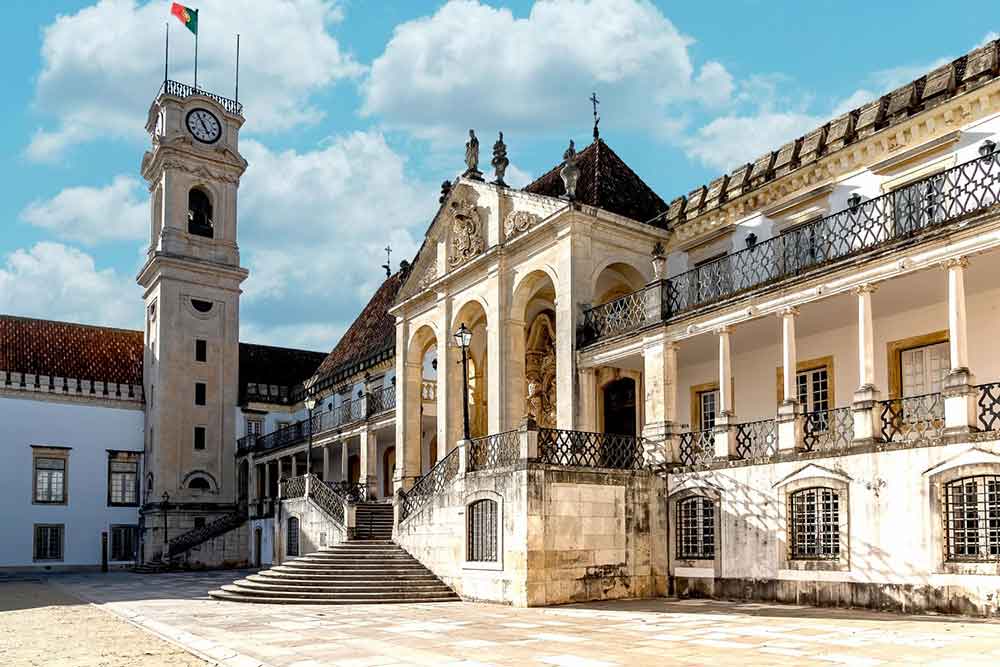
3. Pena Palace, Sintra
You’ve probably seen images of this colourful Insta-worthy palace before. Pena Palace is one of the most popular attractions in Portugal and an easy day trip from Lisbon.
Located in the Serra de Sintra, a mere 30km to the east of Portugal’s capital you’ll find this enchanting site. If you’re pushed for time, the most efficient way to see all the attractions in Sintra is by booking a tour.
The 19th-century, Pena Palace, is built in the Romanticism style. It’s flamboyant, ornate and over the top in every way imaginable, and it wouldn’t look out of place in Disneyland!
The palace perches on top of a hill surrounded by lavish gardens. You’ll lose count of how many colours the place is painted in; reds, blues and yellows with brightly coloured tiles. You will want to spend hours taking in the intricacy of one of the most famous buildings in Portugal.
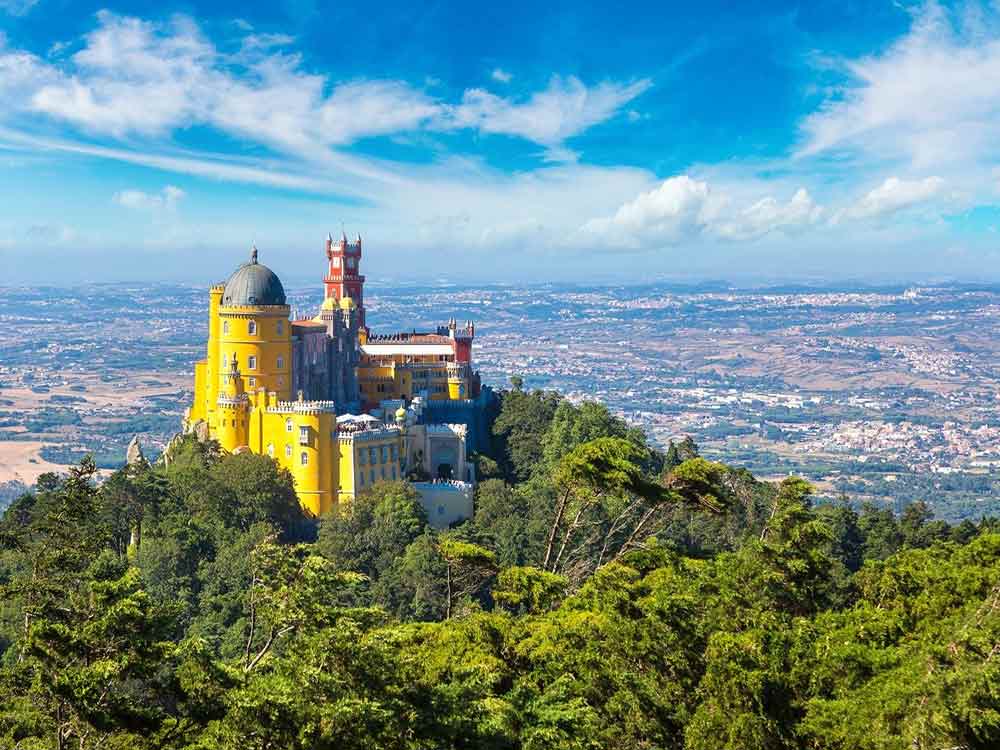
Read Also: How to Do a Lisbon to Sintra Day Trip
4. Quinta da Regaleira, Sintra
Situated close to Pena Palace is another one of Portugal’s top sites, Quinta da Regaleira. If you’re visiting Sintra, be sure to see this outstanding site.
You won’t even question why this stately home came to be listed as one of the top things to see in Portugal. Think of it as an adventure playground for 20th-century aristocrats. Quinta da Regaleira is built in the Gothic style surrounded by extensive landscaped gardens.
Inside the house, is equally as extraordinary. You’ll find intricate detail on every surface, both quirky and traditional, a blend of styles, which both clash and complement each other. It’s remarkable.
The gardens are filled with follies, grottoes, fountains and ponds. However, the most iconic landmark of the gardens at Quinta da Regaleira is the Initiation Well. If you’re into twisted fairytales or have seen the movie Pan’s Labyrinth, you’d be forgiven for thinking you were on the set here.
The Initiation Well drops down 88 feet, with an arched spiral staircase circling the walls to the bottom. The story goes that secret initiation ceremonies, hence the name, took place here but no one knows for sure.
Book Here: Skip-the-Line Entry to Quinta da Regaleira

5. Belém Tower, Lisbon
The Belem Tower or Torre de Belem, is located close to the Jeronimos Monastery, so it’s worth doing both sites at the same time, especially since they share the same UNESCO World Heritage status. Both sites have become two of the most famous Portugal landmarks in the region.
The Tower was built during Portugal’s Age of Exploration to protect the entrance to Lisbon’s Harbour. The style features a mixture of both Medieval and Gothic architecture.
When the tower was originally constructed, it stood on an island, however today you’ll see it pretty much connected to the mainland on a little rocky outcrop. This is due to the 1755 Great Lisbon Earthquake which changed the course of the Targus River.
The Tower of Belem is one of the most important historical landmarks in Portugal as it was pivotal in helping Lisbon gain its wealth during the age of discovery.
If you’re looking for a great vantage point to watch the sunset, then head here in the late afternoon.
Book Here: Belem Guided Tour with River Boat Cruise
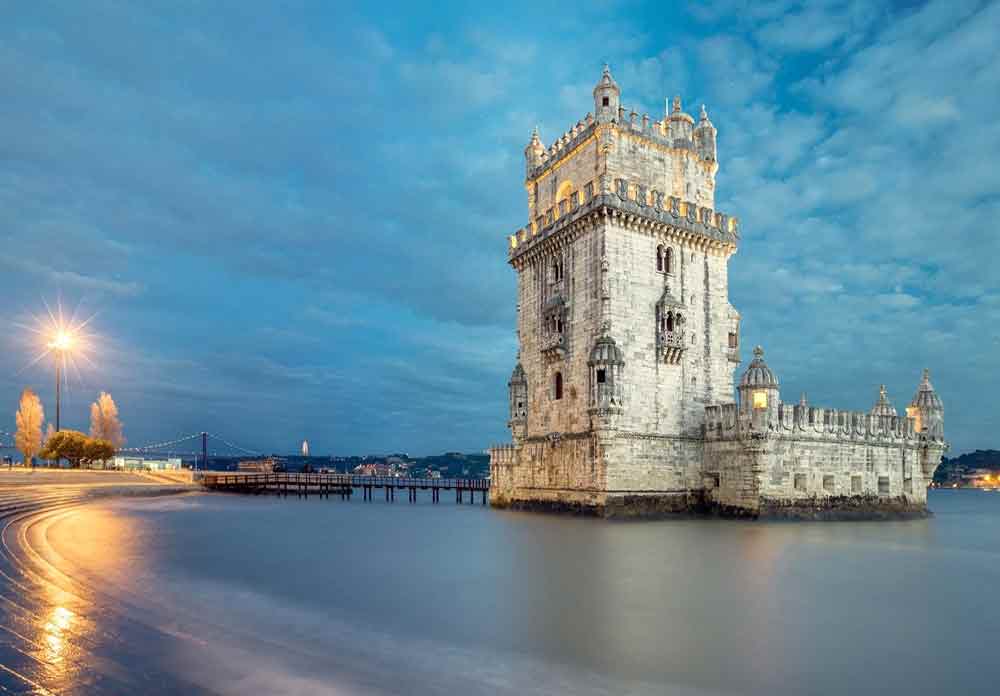
Related Article: Madrid vs Lisbon Comparison Guide
6. Benagil Cave, Algarve
Possibly the most photographed and visited of all the caves on the southern coast and a definite must see along the Algarve coast. Portugal is blessed with numerous caves along this coastal region, and the Benagil Cave is the most popular of them all.
The cave has become synonymous with the Algarve and you’ll see images everywhere of the open-top cave, sending a shaft of golden light into the sand below, reflecting its light off the light-coloured sandstone walls and turquoise blue waters.
The Benagil cave is one of the most famous landmarks of Portugal, if not the most iconic landmark in the region.
The small fishing village of Benagil is the home of this stunning sea cave. The only way of accessing this cave is via the water; either by small boat, kayak or paddleboard.
Book Here: Benagil Caves Kayaking Experience
Book Here: Benagil Caves Stand-Up Paddle Board Tour

The Southern coast of Portugal is also a great place to hop over to nearby Spain – the stunning city of Seville is only about an hour’s drive from the border of Portugal, so you could extend your trip and plan for a Portugal Spain itinerary instead.
7. Dom Luis Bridge, Porto
The famous double-decked iron arc bridge is as synonymous to Porto, as their delicious wine and port is – it’s also worth taking a wine tour along the Duro Valley from here! The Ponte de Dom Luís I or Luís I Bridge stretches over the River Douro. It’s undoubtedly the most iconic landmark in Porto.
At the time of construction, Porto’s arc bridge was the longest bridge of its kind, spanning 172 metres (564 ft) between the cities of Porto and Vila Nova de Gaia. The bridge opened in October 1886 and was the brainchild of Gustave Eiffel (the man behind Paris’ Eiffel Tower).
Both levels of the iconic bridge were initially designed to carry road traffic, one road on the top level, and another road on the lower level of the bridge. However, today Porto’s Metro runs along with the top level as well as a pedestrian walkway.
Great views over the River Duro and Porto can be seen from the top, however, if you’re nervous about heights, take note that it’s a 60 metre (190 ft) drop below. If you’re visiting Porto, be sure to add one of the most major landmarks in Portugal to your itinerary.
Book Here: Wine Tasting Tour of the Duoro Valley
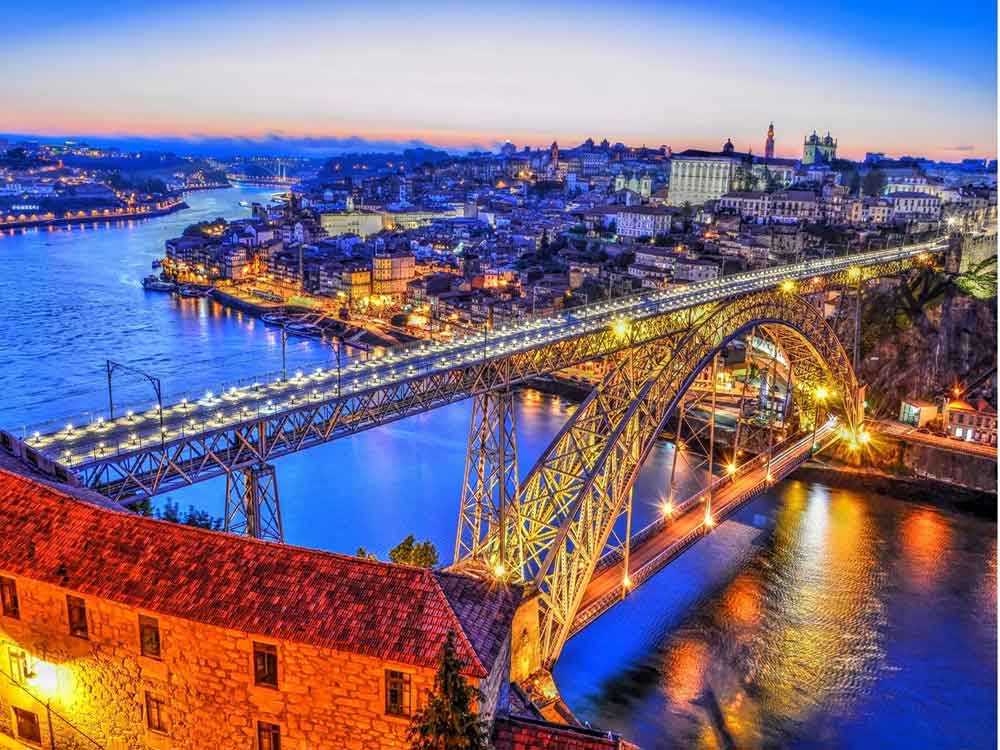
8. Convento de Cristo, Tomar ( Knights Templar)
The 12th-century stronghold looks like it’s been plucked straight out of Game of Thrones. The Convent of Christ in Tomar was run by the Knights Templar and certainly needs to be added to your history of Portugal famous landmarks list.
After the demise of the Templars, the Convento de Cristo then housed the Knights of the Order of Christ.
If you are interested in your religious history, this is a famous landmark in Portugal that won’t disappoint.
There are several tours about the Knights Templar departing here with official guides. Of course, if you just want to go to view the site, you can also walk around on your own. Look out for the small aqueduct just outside of the convent.
Check Availability: Knights Templar Full-Day Guided Tour
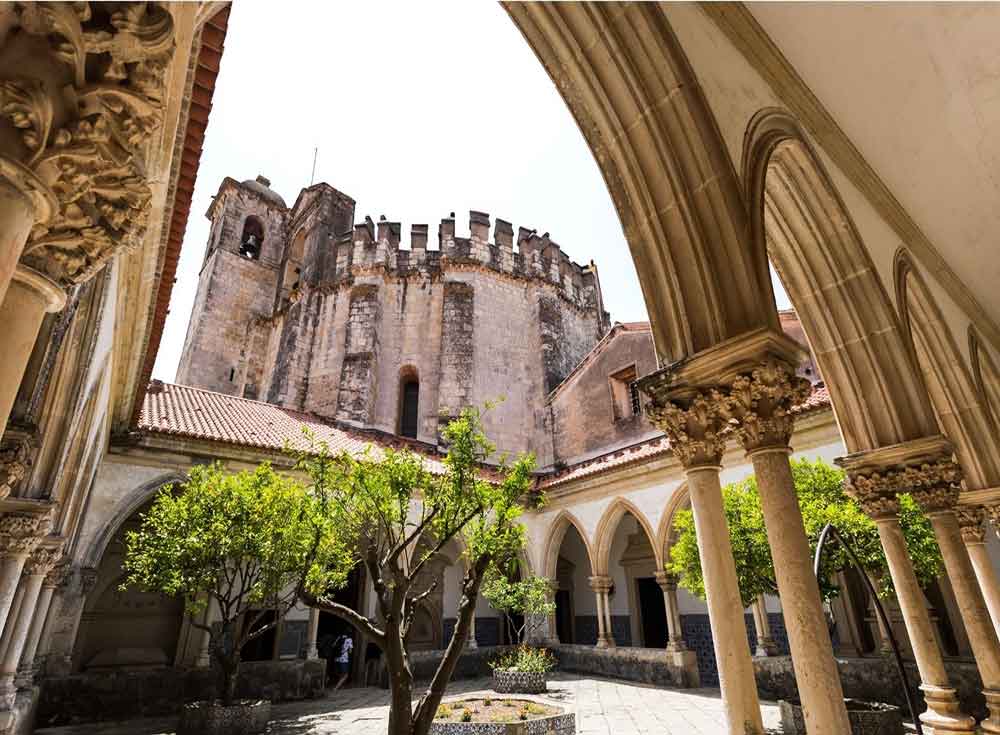
9. Praça do Comércio, Lisbon
If you’re into your history of Portugal, historical places, such as the Praca do Comercio, are in abundance. Located in the heart of the historical centre, you’ll find Lisbon’s Commerce Square.
One side faces the Targus River, while the other three are beautifully lined with alcoved, pillared and arched buildings which dazzle in the sunshine.
Opposite the river, you’ll see the gigantic Arco de Rue Augusta, which the iconic yellow trams trundle past along the cobbled street. If you’re visiting the nation’s capital, certainly add this to your Lisbon itinerary.
Originally, this square was called Terreiro do Paço and was once home to Paços da Ribeira or the Ribeira Palace. Historically, the kings of Portugal resided here, until the site was destroyed during the Great Lisbon Earthquake of 1755.
Book Here: Climb the Rua Augusta Arch
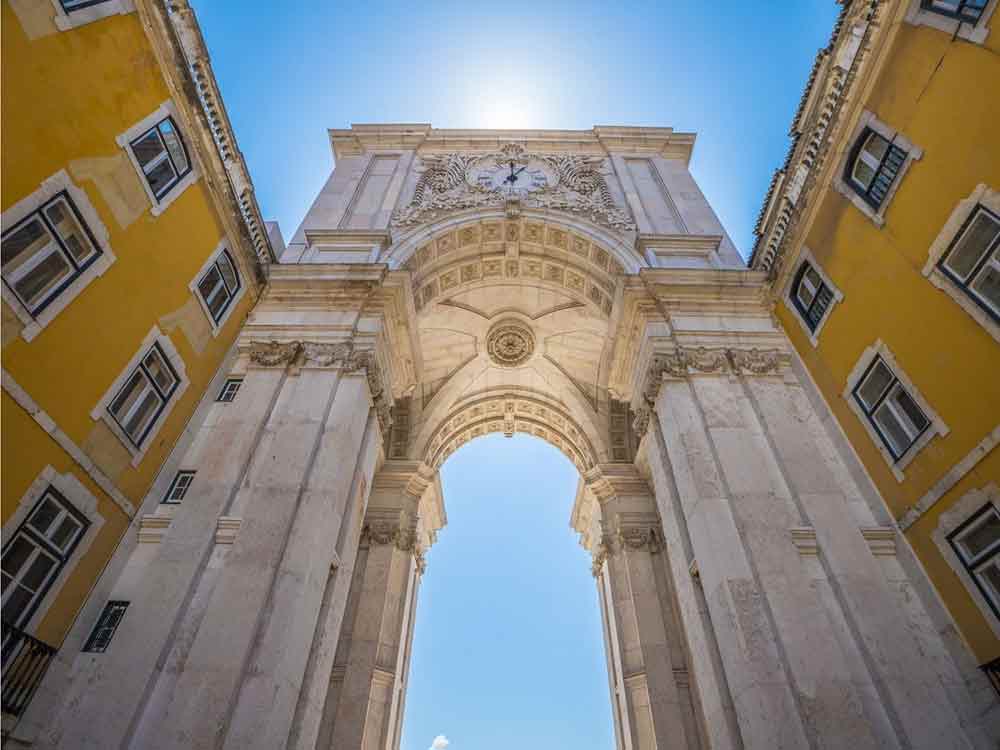
Read Next: How To See The Best of Lisbon in One Day
10. The Azores
The Azores are one of Portugal’s most beautiful natural landmarks and if you’re travelling through Portugal for an extended time, it’s certainly worthwhile taking at least a few days out to this archipelago.
The Azores is a haven if you want to experience the raw power of nature, you’ll find caverns left by lava, mud pools, lakes and forests.
It’s a haven for sustainable tourism and naturally attracts travellers who enjoy outdoor pursuits such as wildlife watching. Whales and dolphins are frequently spotted in the waters surrounding The Azores. The region also offers great hiking, canyoning and scuba diving opportunities.
For the best accommodation options, base yourself in Sao Miguel, the most visited of the Azores Islands.
Book Here: Whale Watching in the Azores
Book Here: Scuba Dive on the Azores
Book Here: Canyoning in the Azores

Related Article: The World’s Best Beaches and Coves
11. Se Cathedral, Lisbon
Built by the first King of Lisbon, the Sé de Lisboa is the oldest church in the city.
Lisbon Cathedral is located in the heart of the historical centre at an intersection. This is one of the most photographed areas of the city, with the iconic yellow trams running past the front of the building.
If you wait long enough, you’ll be able to photograph one of Lisbon’s most famous images and an unforgettable Portuguese landmark.
From Lisbon Cathedral, it’s an easy walk to the district of Alfama and the home of the soulful sounds of the Fado, which is certainly something you should experience when you visit Lisbon.
While you’re in the area, best sure to watch an intimate Fado Show in the nearby Alfama district.

Related Article: Is Lisbon Worth Visiting? 16 Great Reasons to Visit Lisbon
12. Santa Justa Elevator, Lisbon
Built during the industrial age of the 19th century, the Elevador de Santa Justa makes the 45-metre journey for passengers between the Baixa District of Lisbon to the Largo do Como and the viewing platform at the top. Twin this with another great landmark; Rossio Square is situated not far from here.
You might recognise the style of this stunning structure. It was designed by Raoul Mesnier du Ponsard and completed in 1902. Ponsard was a student of the infamous Gustav Eiffel, the guy behind Paris’s Eiffel Tower, you’ll be able to draw parallels between the two monuments.
The wrought-iron structure of the Santa Justa Lift is built in a Neo-Gothic design and features elegant arches and geometric shapes which were prominent in this style. Passengers are transported inside two classic-style, highly polished wooden carriages which makes this one of the most popular Lisbon landmarks.

Related Article: 14 Day Spain and Portugal Itinerary
13. Monument of Discoveries, Lisbon
Although not as beautiful as the palaces, or as grand as the cathedrals, the Padrão dos Descobrimentos is still worthy of its place on this list of the top monuments in Portugal to see. The 52-metre (170 ft) tall landmark commemorates the 500th anniversary of the death of Henry the Navigator.
Henry the Navigator was one of the country’s great explorers and discovered Maderia, Cape Verde and the Azores. He played a key role in the Portugals Age of Discovery which allowed the country to prosper.
The monument sits on an enormous marble mosaic which features a compass with a map of the world in the middle. It looks out to the River Targus and represents a ship. Standing upon the ship are other great explorers from Portugal headed by Henry the Navigator.
At the top of the Padrão dos Descobrimentos is an observation deck, an elevator up the centre that takes you to the top. This is one of the most famous monuments in Portugal from modern times.

14. Ajuda Palace, Lisbon
The stunning neo-classical Palace of Ajuda (Palácio Nacional da Ajuda) is located just outside of the nation’s capital.
Featuring four wings, beautiful gardens and decorative geometric Portuguese pavements called calçada, this became the Royal Residence after the initial palace was destroyed in the Great Lisbon Earthquake in 1755.
After various delays, the Royal Family wasn’t able to move in until the 1860s, and then when the monarchy ended in 1910, it was disbanded.
Today the rooms have fully resorted to their once opulent state which features ornate furniture, ceiling frescos, chandeliers and sumptuous drapery.

15. Queluz National Palace, Lisbon
Located just outside of Lisbon and behind its pretty exterior, the National Palace of Queluz has a slightly disturbing history.
During the 18th century, the palace was the official royal residence of Queen Maria, also known as the mad queen. She was hidden away from public view after the death of her husband in 1786. She was kept in confinement in what is known as ‘Marias Pavilion’.
The external elegant Baroque architecture of the palace is situated in beautifully manicured gardens. Inside is a mixture of Baroque, Rococo and Neoclassical styles. Although the whole palace is remarkable, two notable rooms are the Throne Room and the Ambassadors Room which both ooze pure opulence.
16. Palacio Nacional de Mafra, Lisbon
This enormous complex of the National Palace of Mafra boasts a basilica, a convent and even a game reserve. Both the Royal Convent and the Place building feature important examples of the Baroque movement in Portugal.
Top attractions here also include one of the most beautiful libraries in the world, an 18th-century infirmary and its two carillons which contain 98 bells!
In total, there are more than 1,200 rooms, although not all of them are open for public viewing. These rooms feature more than a staggering 4,700 doors and windows as well as 156 stairways. It’s huge, to say the least!
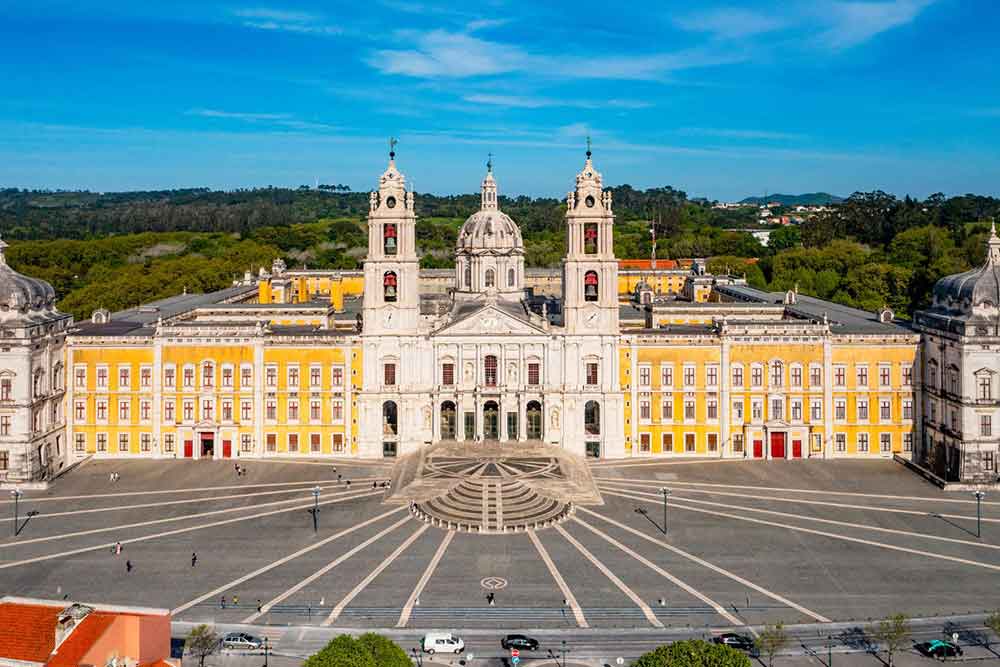
17. Palacio Nacional, Sintra
Portugal’s best-preserved medieval palace is located in Sintra and historically has been favoured by the Portuguese nobility throughout history, starting from the 15th right up to the 19th century. It’s located right in the heart of Sintra town, so the palace sometimes gets the name of Palacio de Vila or the Town Palace.
The National Palace features a Gothic exterior, although it’s far less intricate compared to other buildings of this era. The most striking feature you’ll see are the two gigantic white chimneys coming from the palace kitchens.
This was the most resided of Portugal’s royal palaces. Inside you’ll find ornate and lavish rooms filled with family heirlooms.

18. Palacio de Monserrate, Sintra
This exotic building looks like it’s been plucked from a movie set. This unique palace often gets overlooked by some of the other landmarks in the Sintra region.
Montserrat Palace is a mixture of Gothic and Arabic design, and is one of the most beautiful buildings in the region. Drawing inspiration from Islamic architecture you’ll find delicate latticework, elaborate symmetry and columned arches. It also has a pretty impressive domed atrium.
The Montserrat Palace was commissioned by Sir Frances Cook, who wanted to combine a villa located in an English-style garden. Ornamental lakes, a waterfall feature, as well as ruins of a chapel, are some of the highlights to see here.

19. San Bento Train Station, Porto
Another stunning architectural gem and a must-visit attraction is the San Bento Train Station, located in Porto, Portugal. Inaugurated in 1916, it is renowned as one of the most beautiful train stations in the world.
The station’s interior is adorned with approximately 20,000 traditional azulejo tiles, which depict various aspects of Portugal’s lifestyle, historical battles, royalty, and transportation history.
The name “San Bento” is derived from the Benedictine monastery that once stood on the same site. The station’s design reflects a harmonious blend of architectural styles, showcasing intricate details and magnificent craftsmanship.
The azulejo tiles, with their vibrant colours and detailed designs, create a captivating visual spectacle for visitors.
Beyond its architectural beauty, San Bento Train Station serves as a fully functioning transportation hub, connecting locals and visitors alike to various destinations in and around Porto.

20. Capela das Almas, Porto
This is one of the most beautiful churches you will encounter if you’re passing through Porto.
The stunning blue and white tiled facade of the Capela das Almas de Santa Catarina has become one of the most famous things in Portugal to see, thanks to Instagram.
Because this is one of the most photographed sites in the city arrive early to avoid the queues of people waiting to pose in front of it. Thanks to the influx of travellers posting their images online, it’s quickly become one of the most recognisable Portuguese monuments.
It’s located along Rue de Santa Catarina, on a trendy pedestrianised street. The church dates from the 18th century. The blue and white tiles depict various religious scenes.
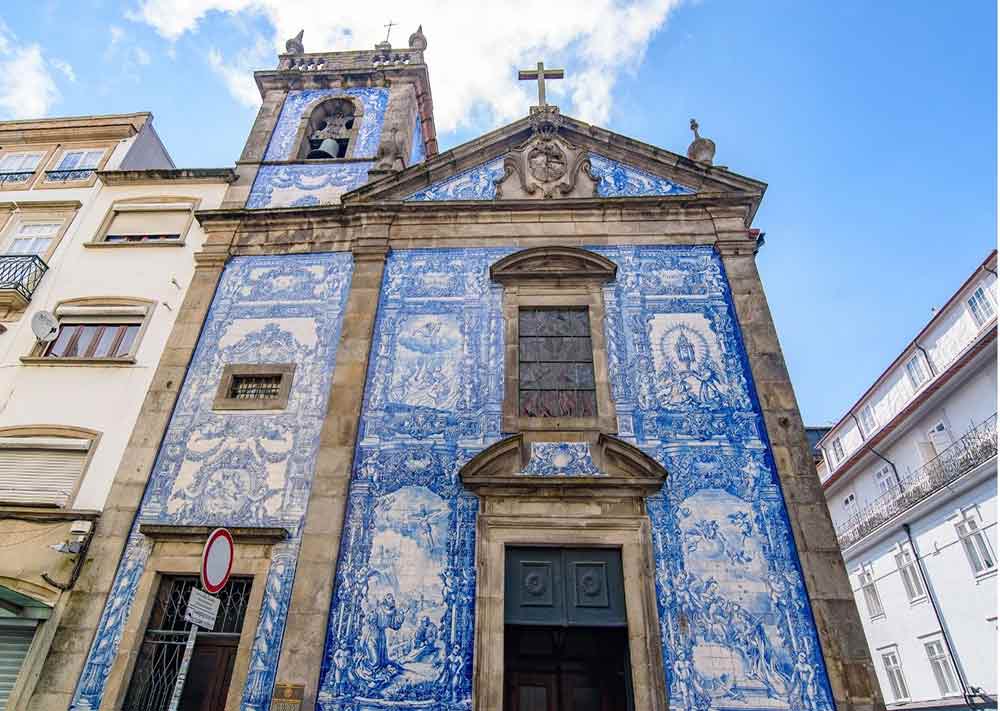
21. Igreja do Carmo, Porto
So here you get two great sites for the price of one. Two churches stand nearly side by side, the Igreja do Carmo and Igreja cos Carmalitas.
The most fascinating thing about the churches is that there is a 1-metre gap separating them. In this narrow gap, there is a house! This is one of the more unusual places to see in this list of Portugal historical sites.
The Igreja do Carmo is the newest of the two churches and was built between 1756 and 1768 in the Baroque style. The Igreja dos Carmelitas was built in the mid-17th century. What’s more, someone actually inhabited this micro house right up to the 1980s.
Previous residents include chaplains, doctors who served the churches and artists who worked on decorating the church.
This tiny house is called Casa Escondida, which translates to ‘Hidden House’.
The origins of just how exactly there came to be this tiny house go back to when the churches were built. There are a few theories, however, this one is the most amusing of the tales. Igreja dos Carmelitas was for nuns, and the Igreja do Carmo was for monks.
The absence of a shared wall between the churches ensured there would be no relations between them; sneaky stuff!

22. Livraria Lello, Porto
If you’re a Harry Potter fan, you will absolutely love this magnificent bookstore. It was said to be the inspiration behind some of the rooms at Hogwarts in JK Rowling’s Harry Potter series.
The Lello Bookshop was the result of two brothers, José and Antonio Lello. Between them and their passion for books and culture, they opened the bookstore.
The interior is simply extraordinary, painters and illustrators were commissioned to create the stunning interior. It was opened in 1906 and remains pretty much the same today as it was back then.
Once inside, you’ll be greeted by the enormous snake-like staircase. The walls are decorated with stained glass and intricate wooden carved panels. Look up to the ceiling, and you’ll find gold-coloured latticework.
Any die-hard fan of Harry Potter will love this Harry Potter Sights and Inspiration Tour around Porto.
23. The Palácio da Bolsa, Porto
Located right in the heart of the city you’ll find Bolsa Palace also known as the Stock Exchange Palace. Today it’s the headquarters of Porto’s Commerical Association. Built on the site of the ruins of St Francis Convent in 1842, the mid-nineteenth neoclassical palace is jaw-droppingly beautiful.
The main courtyard, the Pátio das Nações, is enclosed by a gigantic glass roof letting light flood in, to illuminate the palace. This is one of the top Porto landmarks.
Other notable features are the exquisite marble and granite staircase and the aptly named Golden Room due to its being covered in gold leaf! Also, don’t miss the Arab Room.
Decorated in the Moorish style and inspired by the Alhambra, in Granada, Spain, this serves as a function room for official receptions.
Book Here: Palacio da Bolsa Guided Tour

24. Peneda-Gerês National Park
Peneda-Gerês National Park, located in the northern part of Portugal, is the country’s sole national park, encompassing 72,290 hectares of diverse landscapes.
Within the park, you’ll find a rich variety of fauna, including cows, horses, ibexes, and endangered Iberian wolves. Traditional villages dot the surroundings, offering a glimpse of local culture.
One notable attraction is the Sacred Way, featuring three grand staircases: the Via Crucis, the Staircase of the Five Senses, and the Virtues Staircase.
For a memorable experience, go on the Pedra Bela trail, a scenic four-hour hike through forests and pastures, beginning in the village of Pedra Bela and leading into the majestic mountains of the park.

25. Chapel of Bones, Evora
One of the more eerie suggestions on this Portugal monuments list is this place. If you’re looking for something a little bit more creepy, then you’ll probably enjoy visiting the Chapel of Bones in Evora. This small chapel is one of the best-known monuments in Évora and is located inside the Igreja de Sao Francisco church.
You’ll find the unusual chapel at the entrance of the Church of St Frances. The Capela de Ossos gets its name from the way the interior walls have been decorated. They are covered with human bones and skulls.
The bones are from hundred of bodies which were exhumed in the 16th Century, from the city’s overcrowded graveyards. They were removed from the cemetery to make way for new bodies to be buried there. The belief was that the new resting place (inside the chapel) would make the bodies closer to God.
The macabre display features over 5,000 bones that have been set in cement and decorate the walls from floor to ceiling. The skulls watch you from the roof as you walk below.

26. Escoural Cave, Evora
This is the location of one of the most historical sites in Portugal. These immense caves are famous for their Paleolithic art which include painting and engravings. They were discovered during quarry works and since then have been excavated and dated to the Middle Paleolithic time, over 50,000 years ago.
Hundreds of motifs, paintings and engravings have been discovered at this archaeological site
Visiting Evora? then check out this Evora Two Day Itinerary.
27. Óbidos Castle
Dating back to Portugal’s Roman historical past, Obidos Castle features a whole mix of architectural styles, including Moorish, Gothic and Medieval. The castle has served both as a military stronghold as well as a royal palace.
One of the highlights here is the 1.5km circular walk around the battlements of the castle. The 13 metre-high walls encircle the whole town so it gives you plenty of opportunities to take stunning panoramic photos of the surrounding areas.
Part of the original castle is now a hotel, which still features Manueline windows dating from the 1500s. These Portuguese Gothic-style windows sit alongside the royal coat of arms and the portal.

28. UNESCO Town of Guimaraes
The historic centre of Guimarães gained its status as a UNESCO World Heritage Site in 2001. This is one of the most well-preserved medieval towns in the country.
What’s special here, is that it documents perfectly how Portuguese architecture has evolved from the 15th to the 19th century through its use of traditional building techniques and materials.
If you’re looking for Portugal’s historical places, you’ll find it here. Be sure to visit the city walls to read the inscription ‘Portugal Was Born Here’. This is due to a battle, in which a young Alfonso Enriques fought. Later in his life, Alfonso Enriques went on to become the first king of Portugal.
Other must-see places in Guimares are the Sacred Hill, the Palace of the Dukes of Braganza, and the 11th-century Guimares Castle.
Book Here: Combined Braga and Guimaraes Full Day Tour

29. Bom Jesus do Monte, Braga
The Portuguese Catholic shrine translates to Good Jesus of the Mount. Even if you’re not religious, you’d be hard-pushed not to admire the beautiful staircase. Historically, this site was one of the top Christian pilgrimage sites in Portugal. Top attractions like this hilltop site, now pull in more tourists than pilgrims to Braga.
The Sanctuary of Bom Jesus do Monte gained its UNESCO World Heritage Status in 2019.
Standing at the bottom of the 116 metre (381 ft) zig-zag Baroque stairway you’ll see the chapel at the top, dedicated to the Holy Cross. It dates from 1373 but was rebuilt in the 16th & 17th centuries. It’s worth the climb up to the top, firstly to view the chapel, but also the stunning panoramic views looking out over the valley.
Find out more about this Braga and Guimaraes day tour here.

30. Marvao Castle, Marvao
Built in the late 13th century, Marvão Castle looks out over the surrounding countryside, mountains and even into nearby Spain; it’s a mere 10 miles (15km) away from the border!
The medieval castle features stark and thick granite walls. These walls partially enclose the village. Inside the castle walls, you’ll find the enormous cistern which was used to collect rainwater and the central tower.
There are a plethora of fascinating features of the castle which added to its defences. These include bent entrances and arrow-slit ‘windows’. A triple gate system was used to hinder the progress of any would-be invaders, allowing the army a vantage point for attack.

31. Batalha Monastery, Batalha
The elegant Gothic-style Dominican monastery of Santa Maria da Vitória features gargoyles, pinnacles and buttresses. Batalha Monastery was classified as a UNESCO Heritage site in 1983.
Over 100 statues of biblical figures surround the main doorway. Inside you’ll find beautiful stained glass windows and heavily decorated carvings. Keep exploring the site and you’ll find the appropriately named Capelas Imperfeitas (Unfinished Chapels).
Construction on this large octagon-shaped space began in 1435 but was never completed. Today it remains roofless allowing the sunlight to beam downwards, creating an almost mystical atmosphere.
Check Prices: Batalha Monastery Entrance Ticket

32. Monasterio de Alcobaça, Alcobaca
The Monastery of Alcobaça was commissioned in 1153 by King Alfonso Henriques after the Christian Crusades drove out the Moors who had invaded Portugal. Historical places like this always come with interesting stories.
The Alcobaca Monastery has plenty of frightful histories. One of them is that during the coronation of King Pedro in 1357, he had the body of his murdered wife, Ines de Castro, exhumed and sat the corpse on the queen’s throne. He then demanded that all of his courtiers kissed her hand!
Today, you can see the tomb where Ines de Castro lays, it’s supported by four carved gremlin statues. Each of the gremlins represents one of her assassins.

33. Fort of Sao Joao Baptista, Berlengas Islands
The Fort of São João Baptista das Berlengas sits on an island off the western coast of Portugal. This fort was one of several defensive military structures which were located on the archipelago to protect the nearby town.
The Fort stands on the site of an abandoned monastery. Construction of the fortress started in the middle of the 17th century.
Cut off from the mainland, the rocky outcrop is connected by a walkway of arched bridges. The fortress itself emits a pinkish colour, when the light is right, this is due to the pink granite which it’s constructed from.
Visit the Fort and See the Berlengas Islands by Catamaran
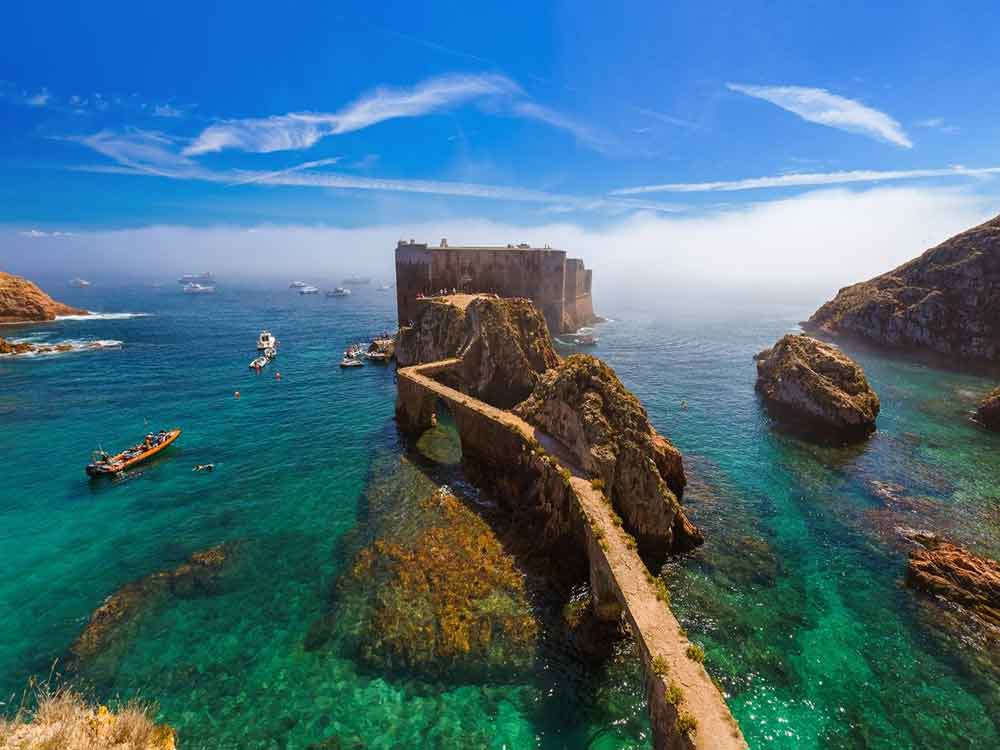
34. Casa de Mateus, Vila Real
The Mateus Palace (Fundação Da Casa De Mateus) features an impressive mansion, a chapel and a vineyard that dates from the 16th century. You may recognise the building as it features on bottles of Mateus rosé!
Explore the extravagant mansion with its ornate stairs and grand interiors showing off how the wealthy lived in Portugal.
Points of interest not to miss include the library. Here features an interesting collection of religious artefacts including some slightly macabre pieces such as a piece of holy fingernail and a set of eyeballs which both come with their certificate of authenticity from the Vatican.

35. Monsanto Village
Dubbed back in 1938 as the most ‘Portuguese town in Portugal‘ this bizarre little town planted itself on Portugal’s map of places to visit.
The reason it’s incredibly unique is that the houses are sandwiched in between gigantic spherical-shaped boulders.
The cute red-roofed houses of the town are located on a mountaintop. The cobbled streets wind in and out of the moss-covered boulders which have amalgamated into part of the town. Some of the boulders even have doors fitted with buildings carved right into the rock.

36. Sanctuary of our Lady of Fatima, Ourém
This is one of the biggest pilgrimage sites in Portugal, not just that, it’s actually listed as the fourth biggest pilgrimage site for Catholics in the world!
Regardless if you’re religious or not, the tales surrounding the popularity of this site are captivating. In short, it is said that three young shepherdesses saw a bright light and that this light was an apparition of a lady. The lady told them to go to Cova da Ira on the 13th day of the month for the next 6 months.
The apparition foretold various events, many came true, and this gained traction with more and more people making the journey to see the apparition.
Check Availability: Full-Day Guided Tour To Fatima, Obidis and the Atlantic Coast

Portugal Famous Landmarks – FAQs
So now you’ve discovered the best landmarks Portugal offers. This section includes helpful tips about visiting Portugal.
What Are the Top 3 Most Famous Landmarks in Portugal?
Three of the most famous landmarks in Portugal are Belém Tower, a UNESCO World Heritage Site and symbol of Lisbon; Pena Palace, a colourful fairytale palace in Sintra; and São Jorge Castle, a medieval fortress offering panoramic views of Lisbon’s historic centre. These iconic landmarks showcase Portugal’s rich history and architectural beauty.
What Are Some Famous Landmarks in Portugal That Can Be Visited From Lisbon?
From Lisbon, you can visit famous landmarks in Portugal such as the Belém Tower within the city. Take a day trip to Sintra to see Pena Palace and Quinta da Regaleira.
Alternatively, explore the coastal town of Cascais known for its beaches and the dramatic Boca do Inferno cliff formation.
What Is the Most Visited Monument in Portugal?
The most visited monument in Portugal is the Jerónimos Monastery in Lisbon. This magnificent UNESCO World Heritage Site is a symbol of Portugal’s rich history and architectural grandeur. Its intricate Manueline-style design and historical significance make it a must-visit attraction for tourists exploring Portugal’s famous buildings.
When Is the Best Time to Visit Portugal?
Portugal has a moderate climate, the summers are warm and the winters are mild compared to other places in Europe. The best weather in Portugal falls between late April to October with the warmest of these being from June to August. The wettest months are in early spring.
If you’re looking to avoid crowds and inflated prices, then try to avoid visiting Portugal during the European summer vacations between July and August.
Ideally, to make the most of the pleasant weather, fewer crowds and shoulder season prices, the best time to visit Portugal is between May and June, and then between September to October.
Is Portugal Easy to Travel Around?
Major cities like Lisbon and Porto are well connected. Regular, cheap and reliable bus and train services run to and from all the major cities. Due to its popularity with tourists, the south coast and the Algarve are also well connected. You could easily fly into Faro in the south, and then take the train up to Lisbon.
To reach some of these famous landmarks in Portugal you will either need your own transport or book a tour which includes transportation. If you choose to hire your own car, you’ll find that Portugal is an easy country to drive in. Roads are well-signposted and maintained.
Is Portugal Safe?
On the whole, Portugal, like most of Europe, is an incredibly safe destination. However, as with all cities, be careful of pickpockets in busy areas.
What Clothes Should I Pack for Portugal?
This will depend on the time of year you visit Portugal. It can get cool in the winter, although when the sun is out it is still pleasant walking about in a t-shirt and jeans. Take a warm jumper for the evenings and the cloudier days.
In the summer months, lightweight clothes are fine. However, it can rain all year round, particularly between February to April. During the summer, the chances of rain are slim, but it can happen. Also near the coast, it can get breezy. Be prepared and pack a lightweight wind and waterproof jacket. Also, don’t forget a comfortable pair of walking shoes.
Which of These Famous Portuguese Landmarks Will You Visit?
This travel guide offers a wide range of famous landmarks in Portugal that you can explore.
From the iconic Belém Tower and Jerónimos Monastery in Lisbon to the enchanting Pena Palace in Sintra and the historic São Jorge Castle in Lisbon, these Portugal landmarks offer something for everyone from the rich tapestry of the history, culture, and architectural brilliance of Portugal.
The tough choice is choosing which ones to visit!
Looking for more things to do on your Portugal itinerary? read more inspirational articles here…
- Spain and Portugal 2-Week Itinerary
- Sintra Day Trip From Lisbon
- 16 Great Reasons to Visit Lisbon
- Best of Lisbon in a Day
- Two Days in Lisbon
Save it for later
If you found this Portuguese landmarks guide useful, save this post for future reference. Know someone else who will find this helpful, then why not share it with them?
Have a question about planning your trip to Portugal? then head to the Contact page and drop me a message.











